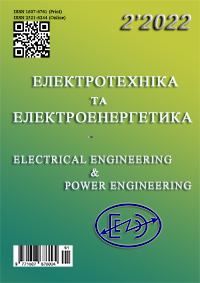Simulation of the electric field of a polymeric insulator bushing to determine the field concentration points
DOI:
https://doi.org/10.15588/1607-6761-2022-2-5Keywords:
bushing insulator, electric field, end element method, modeling, ansys maxwell, electric field strength optimizationAbstract
Purpose. The use of modeling as a tool that allows you to identify design weaknesses in electrical equipment and, on their basis, perform its optimization in order to level weaknesses due to design imperfections. Designation of a real problem in the design of polymer bushings, which negatively affects their technical, economic and operational characteristics and makes them less competitive compared to other types of insulators.
Methodology. Analysis of experiments to detect partial discharges, simulation of electric field strength, synthesis of analyzed works and simulation results.
Findings. As a result of the performed scientific research, it was found that the process of partial discharges has a direct effect on the electrical strength of the polymer bushing insulator. This fact is taken as the basis for searching for methods of further influence on the design of the insulator in order to increase its service life. It was found in the work that the reason for the occurrence of partial discharges is the uneven distribution of the electric field strength. This was the reason for further study of the electric field strength of the pass-through insulator and its modeling. As a result of the simulation, points of concentration of the electric field strength in the bushing polymer insulator were found and designated as points of action to increase the electrical strength of the bushing polymer insulator.
Originality. The scientific novelty of the performed research work lies in the use of the simulation of the electric field of a polymer bushing as a tool for detecting weak points in its design, when exposed to which, a positive effect on its technical characteristics can be observed.
Practical value. The practical value of the research work done is that the results of the research serve as a solid foundation for further optimization of the design of polymer bushings, which will lead to a positive impact on their technical characteristics and make them competitive compared to other types of insulators.
References
On approval of the Transmission System Code. Doc-ument v0309874-18, valid, Edition dated 30.12.2021. Access mode: https://zakon.rada.gov.ua/laws/show/v0309874-18#n23.
Shevchenko, Sergii, et al. "Devising A Method For Re-ducing Active Power Corona Losses Based On Changing The Structural Parameters of A Power Transmission Line." Eastern-European Journal of En-terprise Technologies 1.8 (2022): 115.
Ushakov V.Ya. (1994). Insulation of high voltage in-stallations. M .: Energoatomizdat.
Vershinin Yu.N. (2000). Electron-thermal and subsidy processes in the electrical breakdown of solid dielec-trics. Yekaterinburg: IEF RAS.
Shevchenko, S. YU., D. O. Danylʹchenko, and S. I. Dryvetsʹkyy. "zabezpechennya nadiynoho el-ektropostachannya viysʹkovykh ob'yektiv." Rek-omendovano Vchenoyu radoyu Natsionalʹnoho tekhnichnoho universytetu «Kharkivsʹkyy politekhnichnyy instytut» do druku protokol № 9 vid 24.09. 21 r. KOLEKTYV AVTORIV: Chepkov IB, Bisyk SP, Myronyuk OYU, Slyvinsʹkyy OA (2021): 265.
Wu K. Suzuoki Y, Dissado L.A. (2004). The contribu-tion of discharge area variation to partial discharge pattern in disk voids. J. Phys D. Appl.Phys. 37, No 7. p 1815- 1823
Kupershtoch A.L., Stamatelatos, S.P. Agoris D.P. (2006). Simulation of partial discharges in solid die-lectrics at alternating voltage // Letters to ZhTF. 32 issue. 15. P.74-80
Slutsker A.I., Polikarpov Yu.I., Galyarov V.L. (2006). On elementary acts in the kinetics of electrical de-struction of polymers // JTF. V.76. Issue 12. S.52-56
Paoletti P.E., Golubev A. (1999). Partial discharge the-ory avd applications to electrical equipment. Tappi conference, p.23-46
Noskov M.D., Malinovsky A.S., Zakk M., Shvab A. (2006). Simulation of dendrite growth and partial discharges in epoxy resin II // JTF. E2. Issue 2. pp. 121-128
Polyakov D.A., Terashchenko N.A., Nikitin K.I. To-l_dzhennya v_dm_nnyh features of the characteris-tics of the chastkovy discharges in the passages of the insulator
Diahovchenko, Illia M., (2019). et al. "Protection of Digital Power Meters Under the Influence of Strong Magnetic Fields." 2019 IEEE 2nd Ukraine Confer-ence on Electrical and Computer Engineering (UKRCON). IEEE.
Shevchenko, Sergiy, Dmytro Danylchenko, and Stanislav Dryvetskyi. (2020). "Experimental Re-search of the Electrical Strength of the Insulated Sys-tem “Protected Wire-Line Insulator”." 2020 IEEE 4th International Conference on Intelligent Energy and Power Systems (IEPS). IEEE.
Diahovchenko, Illia, et al. (2019). "Rogowsky coil applications for power measurement under non-sinusoidal field conditions." Energetika 65.1.
Khasawneh, Alaa, et al. (2021). "Methodology for Accounting for the Influence of Dust Cover on the Performance of a Photovoltaic System for Matlab Simulink." 2021 IEEE International Conference on Modern Electrical and Energy Systems (MEES). IEEE
Downloads
Published
How to Cite
Issue
Section
License
Copyright (c) 2022 S.Y. Shevchenko, D.A. Danylchenko, Y.A. Vyazovichenko, A.E. Potryvai, V.N. Tsyupa

This work is licensed under a Creative Commons Attribution 4.0 International License.
Creative Commons Licensing Notifications in the Copyright Notices
Authors who publish with this journal agree to the following terms:
Authors retain copyright and grant the journal right of first publication with the work simultaneously licensed under aCreative Commons Attribution License that allows others to share the work with an acknowledgement of the work's authorship and initial publication in this journal.
Authors are able to enter into separate, additional contractual arrangements for the non-exclusive distribution of the journal's published version of the work (e.g., post it to an institutional repository or publish it in a book), with an acknowledgement of its initial publication in this journal.
Authors are permitted and encouraged to post their work online (e.g., in institutional repositories or on their website) prior to and during the submission process, as it can lead to productive exchanges, as well as earlier and greater citation of published work.

